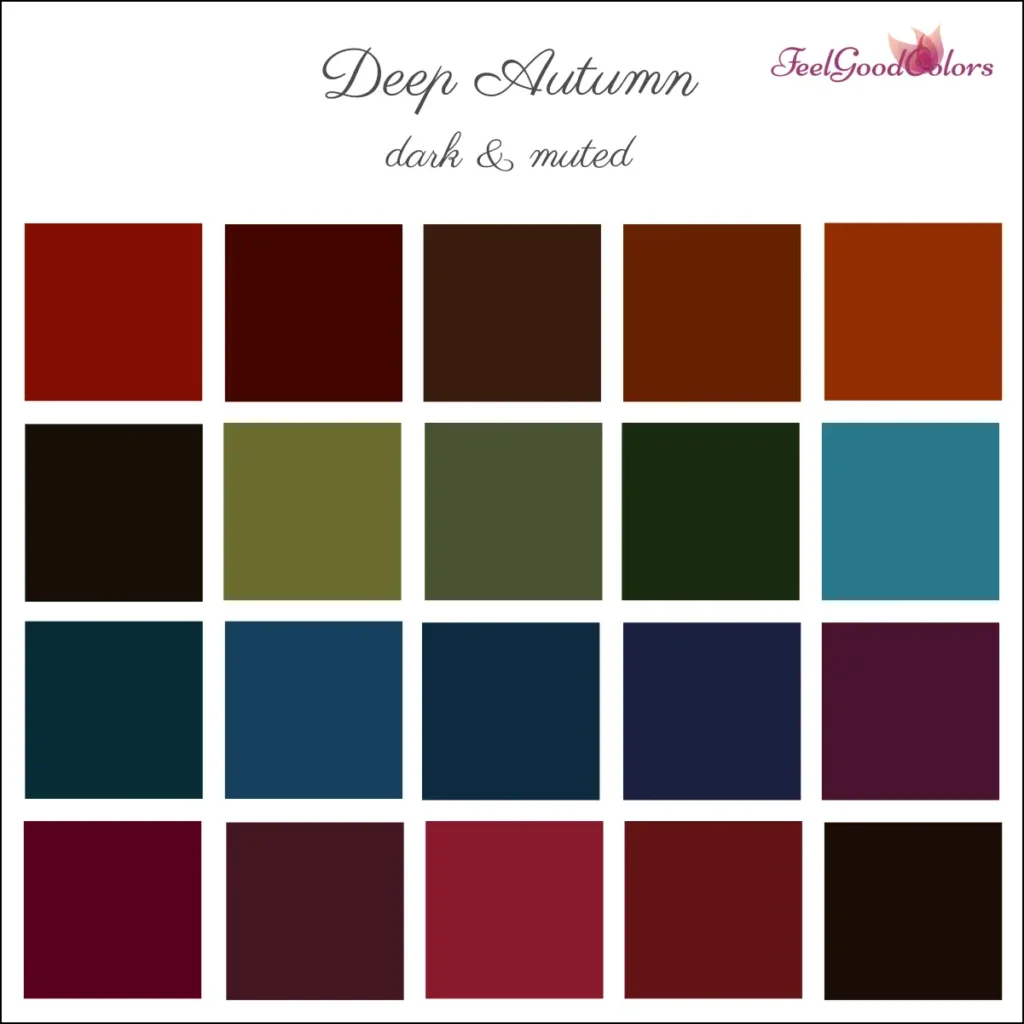Are you having trouble determining your color type? Atypical Deep types – are you one of them? Or are you simply interested in the diversity of atypical color types? Then you’ve come to the right place. For general information on atypical color types, it’s best to read my blog post “Atypical Color Types.” My online course also helps you recognize whether you are an atypical color type.
There are several atypical Deep types. One type that occurs very frequently is actually quite typical but lighter than what is generally defined for Deep types:
Lighter Deep types
In color type consultations, the most common types that approach me are “Deep” types. On the one hand, this is because many people don’t consider that their main characteristic could be Deep if they don’t have very dark hair and eyes. On the other hand, Deep types are sometimes actually unusually light and can even be dark blond. Both cases are very difficult to recognize because, compared to a person with jet-black hair and dark brown eyes, they don’t appear “Deep.” This is mainly due to the misconception caused by the name “Dark Autumn” or “Dark Winter,” which is also used for Deep Autumn or Winter, leading to the mistaken assumption that Deep types must always be dark. However, it’s not just about darkness but also about saturation. A Deep type can generally be very dark or have dark hair, eyes and lips compared to the skin. This can be easily seen in a black-and-white photo. Here, you can see why Deep Winter is directly next to Clear Winter on the color wheel I use. If the contrast of hair, eyes and lips to the skin is very high, and the eyes shine brightly, we have a Clear Winter type.
Deep types that are lighter can use the normal Deep Autumn or Deep Winter color palette.
Intermediate types mainly based on Deep types
Intermediate types are color types that are somewhat between two closely related or similar color types. You can get an overview of frequently occurring intermediate types in my article on Atypical Color Types.
Base Deep Winter
Deep Winter Cool
A Deep Winter whose secondary characteristic “Cool” is very strong. This color type absolutely needs the dark colors. However, it is too far from Autumn for the warmer red and green tones of Deep Winter to fit. This is not uncommon, so I have created an extra palette for this color type. For makeup and clothing, the rules for Deep Winter or Cool Winter apply, which are very similar. I don’t provide an extra color palette for this type because, as you can see, it’s simply the Deep Winter colors with warm colors replaced by cool ones:
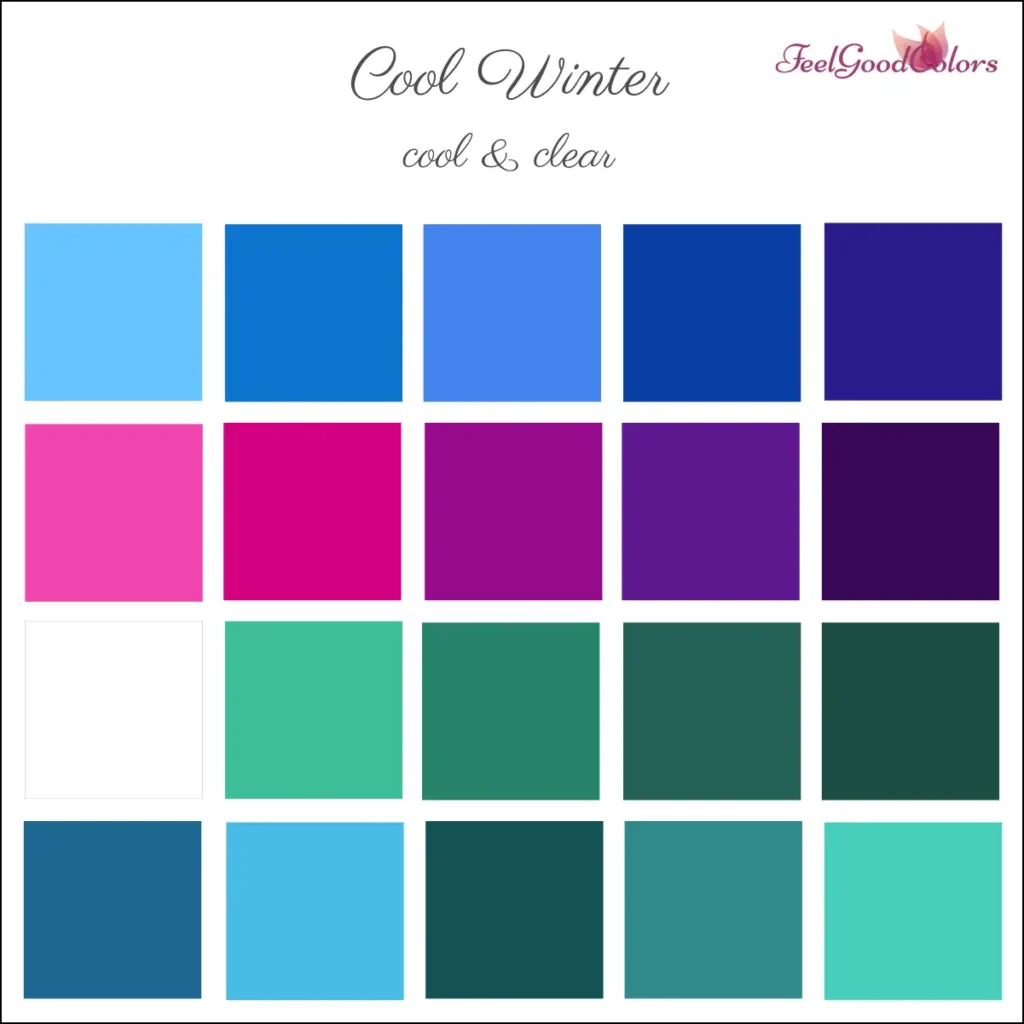
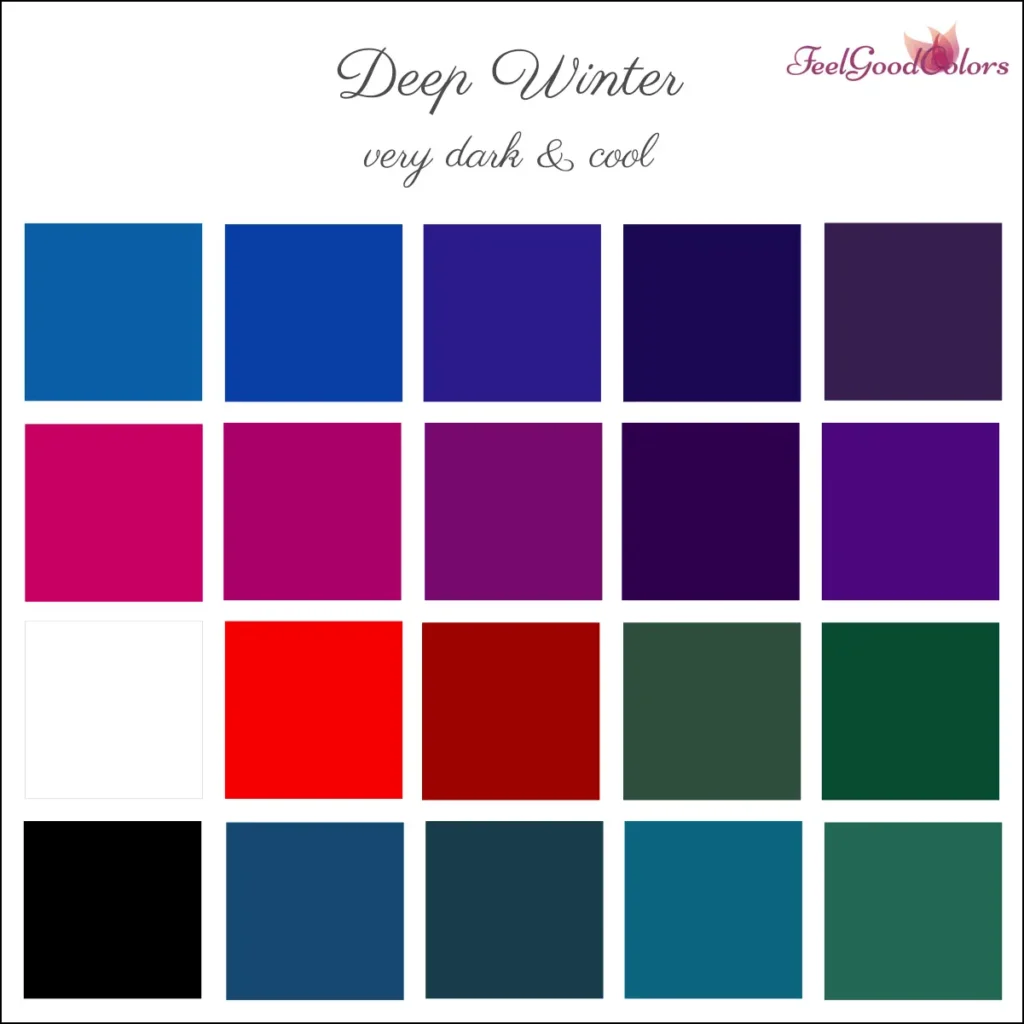

Base Deep Autumn
Based on Deep Autumn, I have noticed 4 intermediate types or atypical Deep types. For 2 of these intermediate types, the same rules apply for combining clothing and makeup as for Deep Autumn.
Soft Autumn Deep
or Deep Autumn Soft. I tend to call it Deep Autumn Soft because according to my seasonal wheel, that’s exactly what it is: a softer Deep Autumn. However, since it is called Soft Autumn Deep or Toned Autumn in various color systems, I adopt the term “Soft Autumn Deep” (SAD) to avoid further confusion.
In comparison to Deep Autumn – whose main characteristic is dark colors and secondary characteristics are muted and warm colors – the Soft Autumn Deep pushes the “soft” characteristic (i.e., muted colors) so far up that it is equivalent to the main characteristic “Dark.” With the Soft Autumn Deep, we have the main characteristics “Dark & Muted” and the secondary characteristic “Warm.” During an analysis, the SAD type is first clearly assigned to the Autumn types. Warm Autumn can then be quickly excluded, but it’s difficult to decide between Soft and Deep. The Deep colors always push the SAD slightly into the background but make them look healthy. They also emphasize their natural colors. The Soft colors neither stand in the background nor in the foreground but usually make the SAD type appear pale and less radiant.
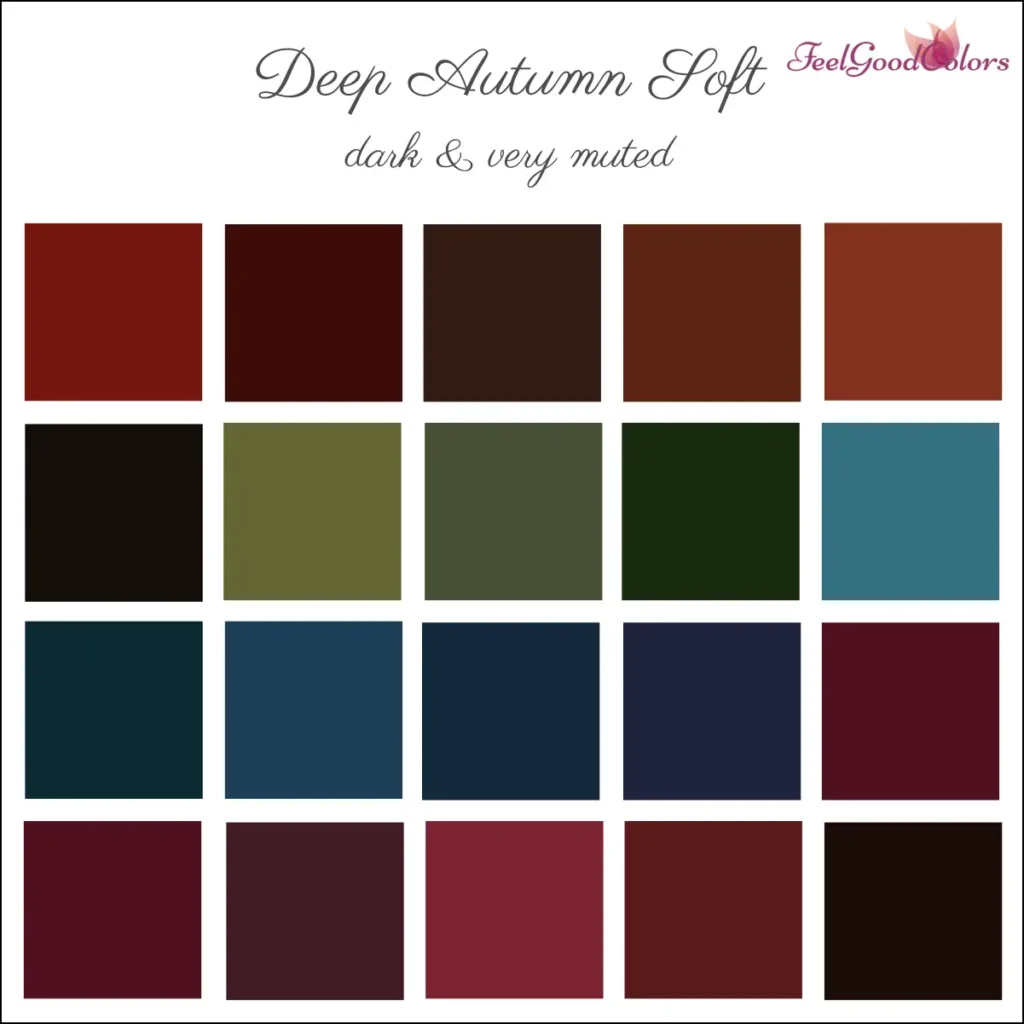
For combinations of clothing and makeup, the same rules apply for SAD as for Soft Autumn. Just choose the colors appropriately dark. For make-up products, you’ll find what you’re looking for at Deep Autumn.
After analyzing several of these atypical Deep types in the weeks leading up to writing this post, I decided to expand my system to include common intermediate types. For those that occur particularly frequently, there will also be color passes available for purchase.
You can find the Seasonal Color Palettse for In-Between-Types here. Color palettes are available for international purchase on my German website. Please use your browser’s translation for checkout. You can find more about my offers for international shipping here.
Deep Autumn Clear
is a contradiction in terms according to the 12-season system, I know. Nevertheless, there are these Deep Autumn types who would look even better in their colors if they weren’t quite as muted. They usually also have very neutral undertones. Very warm characteristics (as is common in Deep Autumn in the eyes, for example) are never found, so the warm orange tones of the actual Deep Autumn palette do not flatter them – just as little as the cool berry tones of the Deep Winter palette.
You could say that Deep Autumn Clear is a little closer to Deep Winter than Deep Autumn. In the Deep Autumn Clear palette, you will therefore find clearer and less warm tones than in the actual Deep Autumn palette. If the colors of Deep Autumn Clear are not enough for you, you can borrow colors from the Deep Winter palette. However, you should avoid the cool tones. Borrowing colors from the Deep Autumn palette is not worthwhile. Essentially, they are the same as those on the Deep Autumn Clear palette, just softer and with a few warmer tones – which you shouldn’t use anyway.
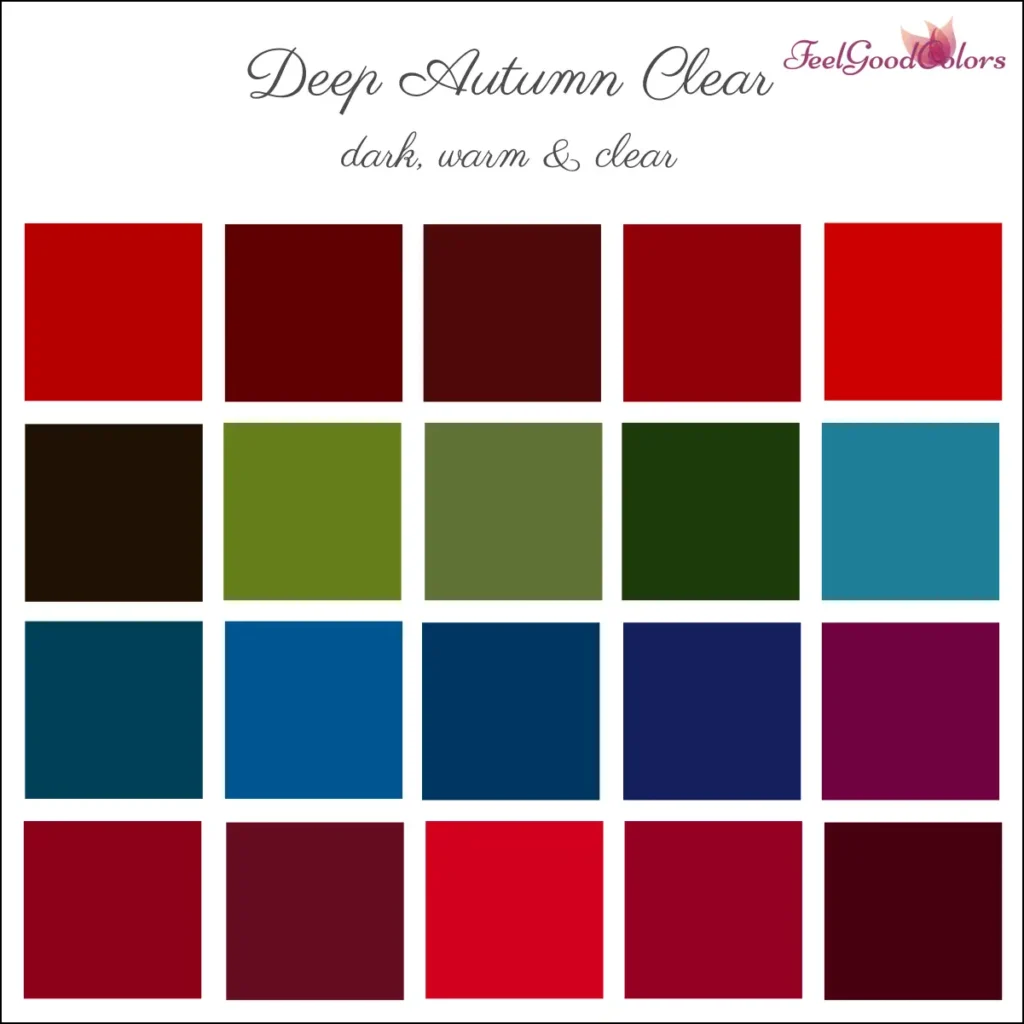
You can buy the color palette for Deep Autumn Clear here. For combining clothing and makeup the same rules apply as for Deep Autumn and Deep Winter.
Deep Autumn Warm
Many will say that this type is not needed because it is already included in Warm Autumn. However, Warm Autumn also contains many light colors, which definitely do not flatter this type as much. Also, all the rules that apply to the combination of clothing and makeup for Warm Autumn do not apply to Deep Autumn Warm because its contrasts and saturation are higher than Warm Autumn. Here, you orient yourself to the instructions for Deep Autumn, just with the correspondingly warm colors.
The Deep Autumn Warm is easiest to recognize by the fact that (except for the dark “warm” blues of Warm Autumn) no blue tones suit them. If you then test the Warm Autumn, you will find that the other WA colors do not support its color scheme very well and make it look rather “bleached” out. Only the dark colors do not.
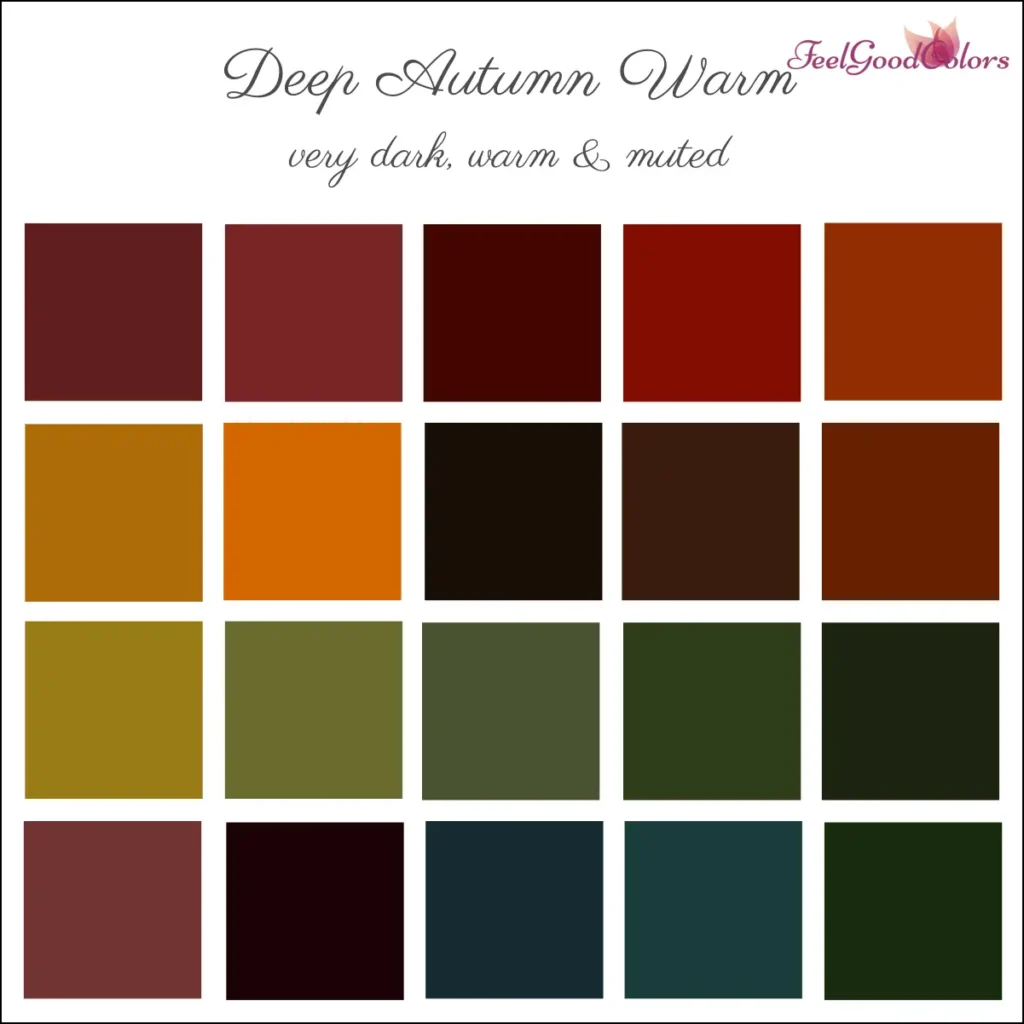
So, in addition to the main characteristic “Dark,” this type also has the equivalent characteristic “Warm.” The color palette is so well adapted to this type that there are actually no other types from which more colors can be borrowed that differ significantly from those of Deep Autumn Warm.
Soft Autumn warmer and darker than typical
A mixture of Soft Autumn Deep and Deep Autumn Warm. This type has no primary characteristic and no secondary characteristics. The characteristics dark, muted, and warm can be considered equally weighted. For combining clothing and makeup, you can refer to the tips for Soft Autumn makeup and clothing, just with the appropriately dark, warm colors.

Atypical Deep types – Comparison of In-Between-Types based on Deep Autumn
Here you can see the intermediate types again in direct comparison, also with the actual Deep Autumn.
In comparing Soft Autumn Deep with Deep Autumn, you can clearly see the respective muted versions of the colors. The same applies to comparing Deep Autumn Warm & Soft with Deep Autumn Warm. With Deep Autumn Clear, you can clearly see that the colors are also dark and neutral-warm, but much clearer than with Deep Autumn.
